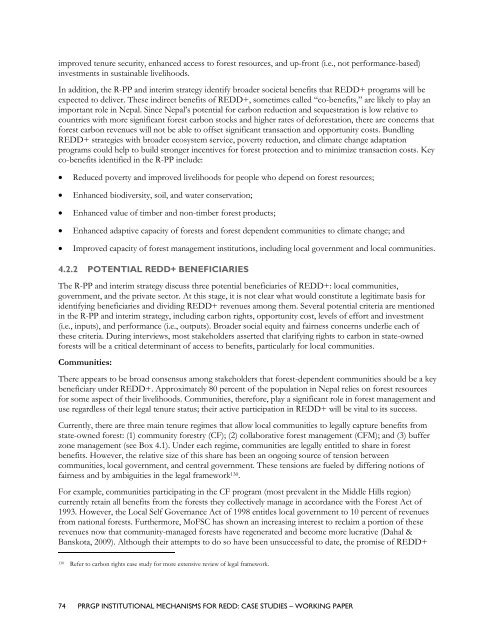Institutional Mechanisms for REDD+ - Case Studies Working Paper
Institutional Mechanisms for REDD+ - Case Studies Working Paper
Institutional Mechanisms for REDD+ - Case Studies Working Paper
You also want an ePaper? Increase the reach of your titles
YUMPU automatically turns print PDFs into web optimized ePapers that Google loves.
improved tenure security, enhanced access to <strong>for</strong>est resources, and up-front (i.e., not per<strong>for</strong>mance-based)<br />
investments in sustainable livelihoods.<br />
In addition, the R-PP and interim strategy identify broader societal benefits that <strong>REDD+</strong> programs will be<br />
expected to deliver. These indirect benefits of <strong>REDD+</strong>, sometimes called ―co-benefits,‖ are likely to play an<br />
important role in Nepal. Since Nepal‘s potential <strong>for</strong> carbon reduction and sequestration is low relative to<br />
countries with more significant <strong>for</strong>est carbon stocks and higher rates of de<strong>for</strong>estation, there are concerns that<br />
<strong>for</strong>est carbon revenues will not be able to offset significant transaction and opportunity costs. Bundling<br />
<strong>REDD+</strong> strategies with broader ecosystem service, poverty reduction, and climate change adaptation<br />
programs could help to build stronger incentives <strong>for</strong> <strong>for</strong>est protection and to minimize transaction costs. Key<br />
co-benefits identified in the R-PP include:<br />
� Reduced poverty and improved livelihoods <strong>for</strong> people who depend on <strong>for</strong>est resources;<br />
� Enhanced biodiversity, soil, and water conservation;<br />
� Enhanced value of timber and non-timber <strong>for</strong>est products;<br />
� Enhanced adaptive capacity of <strong>for</strong>ests and <strong>for</strong>est dependent communities to climate change; and<br />
� Improved capacity of <strong>for</strong>est management institutions, including local government and local communities.<br />
4.2.2 POTENTIAL <strong>REDD+</strong> BENEFICIARIES<br />
The R-PP and interim strategy discuss three potential beneficiaries of <strong>REDD+</strong>: local communities,<br />
government, and the private sector. At this stage, it is not clear what would constitute a legitimate basis <strong>for</strong><br />
identifying beneficiaries and dividing <strong>REDD+</strong> revenues among them. Several potential criteria are mentioned<br />
in the R-PP and interim strategy, including carbon rights, opportunity cost, levels of ef<strong>for</strong>t and investment<br />
(i.e., inputs), and per<strong>for</strong>mance (i.e., outputs). Broader social equity and fairness concerns underlie each of<br />
these criteria. During interviews, most stakeholders asserted that clarifying rights to carbon in state-owned<br />
<strong>for</strong>ests will be a critical determinant of access to benefits, particularly <strong>for</strong> local communities.<br />
Communities:<br />
There appears to be broad consensus among stakeholders that <strong>for</strong>est-dependent communities should be a key<br />
beneficiary under <strong>REDD+</strong>. Approximately 80 percent of the population in Nepal relies on <strong>for</strong>est resources<br />
<strong>for</strong> some aspect of their livelihoods. Communities, there<strong>for</strong>e, play a significant role in <strong>for</strong>est management and<br />
use regardless of their legal tenure status; their active participation in <strong>REDD+</strong> will be vital to its success.<br />
Currently, there are three main tenure regimes that allow local communities to legally capture benefits from<br />
state-owned <strong>for</strong>est: (1) community <strong>for</strong>estry (CF); (2) collaborative <strong>for</strong>est management (CFM); and (3) buffer<br />
zone management (see Box 4.1). Under each regime, communities are legally entitled to share in <strong>for</strong>est<br />
benefits. However, the relative size of this share has been an ongoing source of tension between<br />
communities, local government, and central government. These tensions are fueled by differing notions of<br />
fairness and by ambiguities in the legal framework 130.<br />
For example, communities participating in the CF program (most prevalent in the Middle Hills region)<br />
currently retain all benefits from the <strong>for</strong>ests they collectively manage in accordance with the Forest Act of<br />
1993. However, the Local Self Governance Act of 1998 entitles local government to 10 percent of revenues<br />
from national <strong>for</strong>ests. Furthermore, MoFSC has shown an increasing interest to reclaim a portion of these<br />
revenues now that community-managed <strong>for</strong>ests have regenerated and become more lucrative (Dahal &<br />
Banskota, 2009). Although their attempts to do so have been unsuccessful to date, the promise of <strong>REDD+</strong><br />
130 Refer to carbon rights case study <strong>for</strong> more extensive review of legal framework.<br />
74 PRRGP INSTITUTIONAL MECHANISMS FOR REDD: CASE STUDIES – WORKING PAPER

















